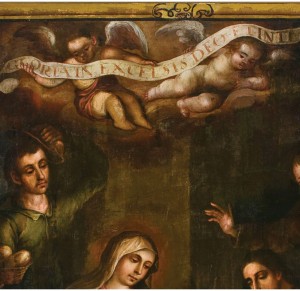The reappearance of Juan Correa’s 17th-century painting The Nativity in the Palace delighted many of us. (See the original post, below.) But a few of us were puzzled by something in the painting. And it didn’t help that our Latin runs a gamut from rusty to non-existent.
Two cherubs hover near the top, holding a banner bearing a Latin phrase. The words? Most of us could make out “Gloria in excelsis Deo,” but were then stumped by what appears to be “E Tinti” or “F Tinti” or maybe “E Tinto.” “F Tinto”?
Here’s a closeup of the painting’s upper half, you take a look:

Was it someone’s name? A colonial version of dead-language name-calling? A 1600s version of Pantone color names?
No one knew. Until Curator Josef Diaz did a little digging around. His answer:
“The text reads Gloria in Excelsis Deo Et In Terra Pax, which translates to Glory in the highest to God and on Earth peace — although in the painting, the banner only reads up to Et In Te, and the rest is cut off. It is the beginning of a hymn known as Gloria. The piece begins with the words that the angels sang when the birth of Christ was announced to shepherds, as seen in the painting. The hymn goes on to say Homnibus Bonae Voluntatis Laudamus Te Benedicimus Te, or To men of good will, we praise thee, we bless thee.”
Ah. Thanks, Josef. Handel wrote a version. So did Vivaldi. For the meditative enjoyment of all, here’s J.S. Bach’s version of the hymn from his Mass in B Minor.

Magister dixit, et mihi placet. Ars longa, vita brevis! Pax vobiscum, Iosephus!
[The master has spoken, and it pleases me. Life is short and art is long! Peace be with you, Joseph!]